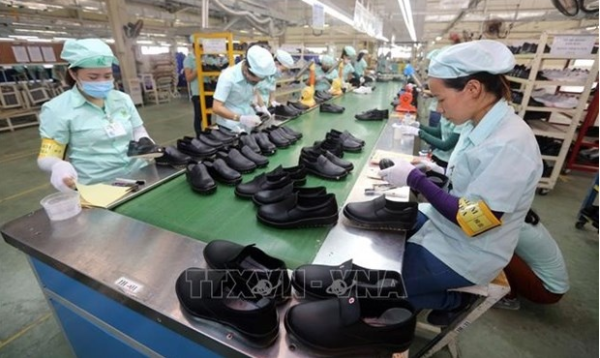
Vietnam is emerging as one of the largest suppliers of footwea®r and leather accessories to the United States, opening more opportunities♣ for domestic companies to exploit the world’s largest market for these goods.
Golden Victory Vietnam Co., Ltd., a foreign-invested enterpris♥e with a factory in the northern province of Nam Dinh, in November 2021 put a solar power system with a capacity of four million kWh per year into operation, with the d esire to meet Nike’s criteria for greening production. Nike has committed to 'reducing greenhouse gas emissions by 65 per cent at its own lo♦cations and by 30 per cent across its supply chain by 2030.
“The number of orders from the US is very large, but only qualif±ied businesses can meet the requirements of social responsibility and for other quality c'ertificates,” said Phan Thi Thanh Xuan, general secretary of the Vietnam Lea±ther, Footwear and Handbag Association (Lefaso).
As soon as Vietnam reopened production, leather and footwear enterprises “received m¥any orders from the US market through the US -Vietnam Trade Council. Customers placed orders$ directly, moving away from other countries,” Xuan said.
Economic indicators and consumption are recovering strongly in the US, helping Vietnam mainta÷in its position as the second-largest leather and foot↑wear exporter to the market since 2012, after China. Footwear exports to the US in÷ the first 10 months of 2021 reached $5.98 billion, accounting for 42 per cent of Vietnam’€s export turnover in this group, up 18.2 per cent over the same period in 2€020.
In 2020, Vietnam sold 453 million pairs of footwear to the US. ViΩetnam could sell more in 2022 when the average American conβsumes more than six pairs of shoes a year. But what worries Lφefaso is that Vietnamese businesses “still have to work with large brands to appear≠ in the market.”
Vietnam’s supply of leather and footwear to the US market comes ma inly in the form of processing orders and importing them backΩ to the US. According to Lefaso, high labour costs in• the US are the main driver of this as companies there could not compete with "imported goods. Currently, the US only has about 250-300 manufacturing companies with about α12,000 workers, but domestic production only meets a mere 1.5 per cent of consumer demand.
A study by the US-Vietnam Trade Council showed that a commo♣n feature of local manufacturers is that they act as outsourcing processors, as they are unable to βdesign their own models. Thus, despite the efforts to promote their own products, local manαufacturers had been unable to attract the attention of buyers.
Further, major brands such as Nike, Reebok, and Bata focus only on design development and sales←, so they need to find production partners. This makes it suitable for ↓domestic enterprises that can meet buyers’ orders, according to set desi♣gn models, without having to rely on the source of raw materials.
American partners understand very well the strengths of the Vietnamese lea ther and footwear industry. They still import goods from Vietnam buβt often through foreign intermediary companies because they do not believe in the domestic enΩterprises’ ability to organise production and manage quality efficiently.
The US is the world’s largest footwear importer, accounting for 40 p®er cent of global footwear imports. Data from Lefaso recognised great competitive ↑pressure for footwear exporters to the US, especially since V ietnam has not yet enjoyed preferential tax rates that are given to some devel÷oping countries. Vietnam also does not have a free trade agreement with the US.
Dao Trong Khoa, general director of T&M Forwarding Co., Ltd. also noted, “Trade wit≠h the US is facing many obstacles related to shipping and supply chain disruption. The lon₩g-distance and no direct shipping routes between the two countries render the costs from ¥Vietnam to the US about 15-20 per cent higher than from China. It takes about 30-45 days for ÷ships to travel from Vietnam to the West Coast of the US compared to 12-18 days from China,” K≥hoa explained.
The challenges are great, but leather and footwear could benefit from the positive achie✔vements in the bilateral relationship when the trade turnover between the two countries ↕reached $100 billion by the end of 2021.
Nguyen Thang Vuong from the European-American Markets Department₹ under the Ministry of Industry and Trade said in November that President Joe ♥Biden has a selective succession policy in applying pressure €to partners in negotiations, thus “Vietnam needs to take careful steps forward.”
According to Vuong, there is a discrepancy between Vietnam and the US when it comes to the r equirements and the ability to meet them. “In the process of negotiating agreements, the USφ always considers Vietnam a trading partner that is benefiting fro'm global uncertainties. Therefore, it is necessary to carefully calculate and b≠alance the trade of both countries,” Vuong said.
Source:Vietnam Investment Review


